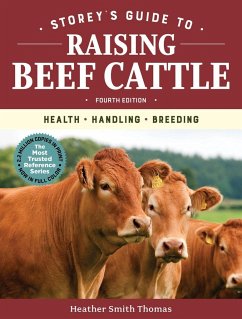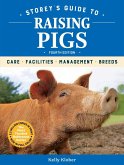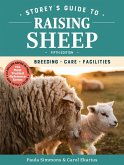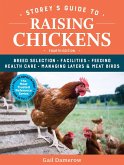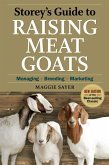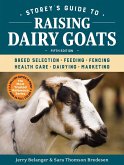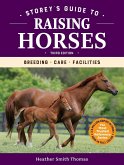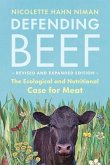22,99 €
inkl. MwSt.
Versandfertig in 2-4 Wochen

11 °P sammeln
- Broschiertes Buch
- Merkliste
- Auf die Merkliste
- Bewerten Bewerten
- Teilen
- Produkt teilen
- Produkterinnerung
- Produkterinnerung
The fourth edition of the most trusted and comprehensive reference on beef cattle health care, breed selection, and grass-fed cattleâ raising techniques is now fully revised and updated, featuring color photography and illustration.
Andere Kunden interessierten sich auch für
![Storey's Guide to Raising Pigs, 4th Edition Storey's Guide to Raising Pigs, 4th Edition]() Kelly KloberStorey's Guide to Raising Pigs, 4th Edition22,99 €
Kelly KloberStorey's Guide to Raising Pigs, 4th Edition22,99 €![Storey's Guide to Raising Sheep, 5th Edition Storey's Guide to Raising Sheep, 5th Edition]() Carol EkariusStorey's Guide to Raising Sheep, 5th Edition22,99 €
Carol EkariusStorey's Guide to Raising Sheep, 5th Edition22,99 €![Storey's Guide to Raising Chickens, 4th Edition Storey's Guide to Raising Chickens, 4th Edition]() Gail DamerowStorey's Guide to Raising Chickens, 4th Edition24,99 €
Gail DamerowStorey's Guide to Raising Chickens, 4th Edition24,99 €![Storey's Guide to Raising Meat Goats Storey's Guide to Raising Meat Goats]() Maggie SayerStorey's Guide to Raising Meat Goats18,99 €
Maggie SayerStorey's Guide to Raising Meat Goats18,99 €![Storey's Guide to Raising Dairy Goats, 5th Edition Storey's Guide to Raising Dairy Goats, 5th Edition]() Jerry BelangerStorey's Guide to Raising Dairy Goats, 5th Edition23,99 €
Jerry BelangerStorey's Guide to Raising Dairy Goats, 5th Edition23,99 €![Storey's Guide to Raising Horses, 3rd Edition Storey's Guide to Raising Horses, 3rd Edition]() Heather Smith ThomasStorey's Guide to Raising Horses, 3rd Edition26,99 €
Heather Smith ThomasStorey's Guide to Raising Horses, 3rd Edition26,99 €![Defending Beef Defending Beef]() Nicolette Hahn NimanDefending Beef18,99 €
Nicolette Hahn NimanDefending Beef18,99 €-
-
-
The fourth edition of the most trusted and comprehensive reference on beef cattle health care, breed selection, and grass-fed cattleâ raising techniques is now fully revised and updated, featuring color photography and illustration.
Hinweis: Dieser Artikel kann nur an eine deutsche Lieferadresse ausgeliefert werden.
Hinweis: Dieser Artikel kann nur an eine deutsche Lieferadresse ausgeliefert werden.
Produktdetails
- Produktdetails
- Verlag: Workman Publishing
- Seitenzahl: 320
- Erscheinungstermin: 27. November 2018
- Englisch
- Abmessung: 234mm x 177mm x 17mm
- Gewicht: 732g
- ISBN-13: 9781635860399
- ISBN-10: 1635860393
- Artikelnr.: 50446496
- Herstellerkennzeichnung
- Libri GmbH
- Europaallee 1
- 36244 Bad Hersfeld
- gpsr@libri.de
- Verlag: Workman Publishing
- Seitenzahl: 320
- Erscheinungstermin: 27. November 2018
- Englisch
- Abmessung: 234mm x 177mm x 17mm
- Gewicht: 732g
- ISBN-13: 9781635860399
- ISBN-10: 1635860393
- Artikelnr.: 50446496
- Herstellerkennzeichnung
- Libri GmbH
- Europaallee 1
- 36244 Bad Hersfeld
- gpsr@libri.de
Heather Smith Thomas has written extensively on animal health care, authoring thousands of articles and 24 books on the subject. Her books include Storey’s Guide to Raising Beef Cattle, Essential Guide to Calving, Getting Started with Beef & Dairy Cattle, The Cattle Health Handbook, The Horse Conformation Handbook, Storey’s Guide to Raising Horses, Storey’s Guide to Training Horses, and Stable Smarts. She raises cattle and horses on her family ranch in Salmon, Idaho.
Foreword by Baxter Black, DVM Chapter 1 Breeds and Genetics: An Overview Choosing Beef Cattle
Breeds and Types of Beef Cattle
Which Type Is Best?
Inheritance of Traits
Crossbreeding and Hybrid Vigor
Selecting for Certain Characteristics Chapter 2: Handling and Behavior of Beef Cattle Basic Cow Psychology
Grazing Behavior
Training Cattle
Moving Cattle
Avoiding Injury Chapter 3: Issues in Buying and Selling Buying a Weaned Calf to Raise for Beef
Buying Calves at Auction
Buying from a Farmer
Buying a Heifer
What Makes a Good Beef Cow?
Buying Pregnant Heifers or Cows
Buying Open Yearlings
Marketing Cattle
Dealing with Shrink
Getting Cattle Ready for Market Chapter 4: General Guidelines for Raising Beef Cattle Understanding Your Calf's Behavior
Care for the Weaned Calf
Winter Care of the New Calf
Summer Care of the Yearling
The End Product: Beef
Feeds and Finishing Chapter 5: Pasture, Fencing, and Facilities Pastures: Sizes and Types
Water
Pasture Fencing
Pens and Facilities
Working in Corrals
Feeding Facilities
Equipment and Supplies Chapter 6: Feeding Cattle Basic Nutrition
Digestion
Feeding Forages (Roughages)
Nutritional Needs Vary
Winter Feeding Chapter 7: Keeping Cattle Healthy Know What a Healthy Animal Looks Like
Vaccinations
Bovine Respiratory Disease
Clostridial Diseases
Rabies
Coccidiosis
Eye Problems
Foot Rot
Lump Jaw
Bony Lump Jaw
Mastitis in Beef Cows
Hardware Disease
Urinary Calculi (Bladder Stones)
Bloat
Acidosis and Laminitis
Poisoning: Toxic Plants
Emphysema
Nitrate Poisoning
Internal Parasites
External Parasites
Skin Problems
Porcupine Quills
Snakebite
Strangulated Teat from Hairy Udder Chapter 8: Growing and Breeding Heifers Feeding Weaned Heifers
Age at Puberty
When to Breed
Nutrition for the Pregnant Yearling
Basics of Reproduction in Cattle
Choosing the Bull and Getting the Heifer Bred Chapter 9: Care of the Pregnant Cow Nutrition
Disease Prevention
Problems of Pregnancy Chapter 10: Calving Create a Safe Environment for Calving
Calving Facilities
Cold
Weather Calving
Handling Cows at Calving Time
Signs of Approaching Parturition
Minimizing Calving Problems: Getting the Calves Born Alive
First Things First: Get the Calf Breathing Chapter 11: Care of the Newborn Calf First Breath
Care of the Umbilical Cord
Helping a Calf to Nurse
Importance of Colostrum
Helping in Different Situations Chapter 12: Calf Health Calfhood Immunity: The Role of Antibodies
Castration
Dehorning
Detecting Illness in Young Calves
Managing Scours
Treating Diarrhea and Gut Infections in Calves
Pneumonia in Young Calves
Diphtheria in Calves
Navel Infections and Joint Ill
Catching Calves for Doctoring
Using an Esophageal Feeder
Giving Oral Medications
Broken Bones
Birth Defects in Young Calves Chapter 13: Weaning the Calves The Importance of When You Wean
Stress of Weaning
Vaccinations
Dehorning Chapter 14: Rebreeding Feeding the Cow after Calving
Cow Fertility
Use of Bulls
Reproductive Behavior of Cows and Bulls
Breeding Ability of Bulls
Artificial Insemination Glossary Resources Metric Conversion Charts Index
Breeds and Types of Beef Cattle
Which Type Is Best?
Inheritance of Traits
Crossbreeding and Hybrid Vigor
Selecting for Certain Characteristics Chapter 2: Handling and Behavior of Beef Cattle Basic Cow Psychology
Grazing Behavior
Training Cattle
Moving Cattle
Avoiding Injury Chapter 3: Issues in Buying and Selling Buying a Weaned Calf to Raise for Beef
Buying Calves at Auction
Buying from a Farmer
Buying a Heifer
What Makes a Good Beef Cow?
Buying Pregnant Heifers or Cows
Buying Open Yearlings
Marketing Cattle
Dealing with Shrink
Getting Cattle Ready for Market Chapter 4: General Guidelines for Raising Beef Cattle Understanding Your Calf's Behavior
Care for the Weaned Calf
Winter Care of the New Calf
Summer Care of the Yearling
The End Product: Beef
Feeds and Finishing Chapter 5: Pasture, Fencing, and Facilities Pastures: Sizes and Types
Water
Pasture Fencing
Pens and Facilities
Working in Corrals
Feeding Facilities
Equipment and Supplies Chapter 6: Feeding Cattle Basic Nutrition
Digestion
Feeding Forages (Roughages)
Nutritional Needs Vary
Winter Feeding Chapter 7: Keeping Cattle Healthy Know What a Healthy Animal Looks Like
Vaccinations
Bovine Respiratory Disease
Clostridial Diseases
Rabies
Coccidiosis
Eye Problems
Foot Rot
Lump Jaw
Bony Lump Jaw
Mastitis in Beef Cows
Hardware Disease
Urinary Calculi (Bladder Stones)
Bloat
Acidosis and Laminitis
Poisoning: Toxic Plants
Emphysema
Nitrate Poisoning
Internal Parasites
External Parasites
Skin Problems
Porcupine Quills
Snakebite
Strangulated Teat from Hairy Udder Chapter 8: Growing and Breeding Heifers Feeding Weaned Heifers
Age at Puberty
When to Breed
Nutrition for the Pregnant Yearling
Basics of Reproduction in Cattle
Choosing the Bull and Getting the Heifer Bred Chapter 9: Care of the Pregnant Cow Nutrition
Disease Prevention
Problems of Pregnancy Chapter 10: Calving Create a Safe Environment for Calving
Calving Facilities
Cold
Weather Calving
Handling Cows at Calving Time
Signs of Approaching Parturition
Minimizing Calving Problems: Getting the Calves Born Alive
First Things First: Get the Calf Breathing Chapter 11: Care of the Newborn Calf First Breath
Care of the Umbilical Cord
Helping a Calf to Nurse
Importance of Colostrum
Helping in Different Situations Chapter 12: Calf Health Calfhood Immunity: The Role of Antibodies
Castration
Dehorning
Detecting Illness in Young Calves
Managing Scours
Treating Diarrhea and Gut Infections in Calves
Pneumonia in Young Calves
Diphtheria in Calves
Navel Infections and Joint Ill
Catching Calves for Doctoring
Using an Esophageal Feeder
Giving Oral Medications
Broken Bones
Birth Defects in Young Calves Chapter 13: Weaning the Calves The Importance of When You Wean
Stress of Weaning
Vaccinations
Dehorning Chapter 14: Rebreeding Feeding the Cow after Calving
Cow Fertility
Use of Bulls
Reproductive Behavior of Cows and Bulls
Breeding Ability of Bulls
Artificial Insemination Glossary Resources Metric Conversion Charts Index
Foreword by Baxter Black, DVM Chapter 1 Breeds and Genetics: An Overview Choosing Beef Cattle
Breeds and Types of Beef Cattle
Which Type Is Best?
Inheritance of Traits
Crossbreeding and Hybrid Vigor
Selecting for Certain Characteristics Chapter 2: Handling and Behavior of Beef Cattle Basic Cow Psychology
Grazing Behavior
Training Cattle
Moving Cattle
Avoiding Injury Chapter 3: Issues in Buying and Selling Buying a Weaned Calf to Raise for Beef
Buying Calves at Auction
Buying from a Farmer
Buying a Heifer
What Makes a Good Beef Cow?
Buying Pregnant Heifers or Cows
Buying Open Yearlings
Marketing Cattle
Dealing with Shrink
Getting Cattle Ready for Market Chapter 4: General Guidelines for Raising Beef Cattle Understanding Your Calf's Behavior
Care for the Weaned Calf
Winter Care of the New Calf
Summer Care of the Yearling
The End Product: Beef
Feeds and Finishing Chapter 5: Pasture, Fencing, and Facilities Pastures: Sizes and Types
Water
Pasture Fencing
Pens and Facilities
Working in Corrals
Feeding Facilities
Equipment and Supplies Chapter 6: Feeding Cattle Basic Nutrition
Digestion
Feeding Forages (Roughages)
Nutritional Needs Vary
Winter Feeding Chapter 7: Keeping Cattle Healthy Know What a Healthy Animal Looks Like
Vaccinations
Bovine Respiratory Disease
Clostridial Diseases
Rabies
Coccidiosis
Eye Problems
Foot Rot
Lump Jaw
Bony Lump Jaw
Mastitis in Beef Cows
Hardware Disease
Urinary Calculi (Bladder Stones)
Bloat
Acidosis and Laminitis
Poisoning: Toxic Plants
Emphysema
Nitrate Poisoning
Internal Parasites
External Parasites
Skin Problems
Porcupine Quills
Snakebite
Strangulated Teat from Hairy Udder Chapter 8: Growing and Breeding Heifers Feeding Weaned Heifers
Age at Puberty
When to Breed
Nutrition for the Pregnant Yearling
Basics of Reproduction in Cattle
Choosing the Bull and Getting the Heifer Bred Chapter 9: Care of the Pregnant Cow Nutrition
Disease Prevention
Problems of Pregnancy Chapter 10: Calving Create a Safe Environment for Calving
Calving Facilities
Cold
Weather Calving
Handling Cows at Calving Time
Signs of Approaching Parturition
Minimizing Calving Problems: Getting the Calves Born Alive
First Things First: Get the Calf Breathing Chapter 11: Care of the Newborn Calf First Breath
Care of the Umbilical Cord
Helping a Calf to Nurse
Importance of Colostrum
Helping in Different Situations Chapter 12: Calf Health Calfhood Immunity: The Role of Antibodies
Castration
Dehorning
Detecting Illness in Young Calves
Managing Scours
Treating Diarrhea and Gut Infections in Calves
Pneumonia in Young Calves
Diphtheria in Calves
Navel Infections and Joint Ill
Catching Calves for Doctoring
Using an Esophageal Feeder
Giving Oral Medications
Broken Bones
Birth Defects in Young Calves Chapter 13: Weaning the Calves The Importance of When You Wean
Stress of Weaning
Vaccinations
Dehorning Chapter 14: Rebreeding Feeding the Cow after Calving
Cow Fertility
Use of Bulls
Reproductive Behavior of Cows and Bulls
Breeding Ability of Bulls
Artificial Insemination Glossary Resources Metric Conversion Charts Index
Breeds and Types of Beef Cattle
Which Type Is Best?
Inheritance of Traits
Crossbreeding and Hybrid Vigor
Selecting for Certain Characteristics Chapter 2: Handling and Behavior of Beef Cattle Basic Cow Psychology
Grazing Behavior
Training Cattle
Moving Cattle
Avoiding Injury Chapter 3: Issues in Buying and Selling Buying a Weaned Calf to Raise for Beef
Buying Calves at Auction
Buying from a Farmer
Buying a Heifer
What Makes a Good Beef Cow?
Buying Pregnant Heifers or Cows
Buying Open Yearlings
Marketing Cattle
Dealing with Shrink
Getting Cattle Ready for Market Chapter 4: General Guidelines for Raising Beef Cattle Understanding Your Calf's Behavior
Care for the Weaned Calf
Winter Care of the New Calf
Summer Care of the Yearling
The End Product: Beef
Feeds and Finishing Chapter 5: Pasture, Fencing, and Facilities Pastures: Sizes and Types
Water
Pasture Fencing
Pens and Facilities
Working in Corrals
Feeding Facilities
Equipment and Supplies Chapter 6: Feeding Cattle Basic Nutrition
Digestion
Feeding Forages (Roughages)
Nutritional Needs Vary
Winter Feeding Chapter 7: Keeping Cattle Healthy Know What a Healthy Animal Looks Like
Vaccinations
Bovine Respiratory Disease
Clostridial Diseases
Rabies
Coccidiosis
Eye Problems
Foot Rot
Lump Jaw
Bony Lump Jaw
Mastitis in Beef Cows
Hardware Disease
Urinary Calculi (Bladder Stones)
Bloat
Acidosis and Laminitis
Poisoning: Toxic Plants
Emphysema
Nitrate Poisoning
Internal Parasites
External Parasites
Skin Problems
Porcupine Quills
Snakebite
Strangulated Teat from Hairy Udder Chapter 8: Growing and Breeding Heifers Feeding Weaned Heifers
Age at Puberty
When to Breed
Nutrition for the Pregnant Yearling
Basics of Reproduction in Cattle
Choosing the Bull and Getting the Heifer Bred Chapter 9: Care of the Pregnant Cow Nutrition
Disease Prevention
Problems of Pregnancy Chapter 10: Calving Create a Safe Environment for Calving
Calving Facilities
Cold
Weather Calving
Handling Cows at Calving Time
Signs of Approaching Parturition
Minimizing Calving Problems: Getting the Calves Born Alive
First Things First: Get the Calf Breathing Chapter 11: Care of the Newborn Calf First Breath
Care of the Umbilical Cord
Helping a Calf to Nurse
Importance of Colostrum
Helping in Different Situations Chapter 12: Calf Health Calfhood Immunity: The Role of Antibodies
Castration
Dehorning
Detecting Illness in Young Calves
Managing Scours
Treating Diarrhea and Gut Infections in Calves
Pneumonia in Young Calves
Diphtheria in Calves
Navel Infections and Joint Ill
Catching Calves for Doctoring
Using an Esophageal Feeder
Giving Oral Medications
Broken Bones
Birth Defects in Young Calves Chapter 13: Weaning the Calves The Importance of When You Wean
Stress of Weaning
Vaccinations
Dehorning Chapter 14: Rebreeding Feeding the Cow after Calving
Cow Fertility
Use of Bulls
Reproductive Behavior of Cows and Bulls
Breeding Ability of Bulls
Artificial Insemination Glossary Resources Metric Conversion Charts Index
